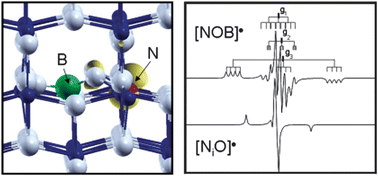Nitrogen boron co-doped TiO2 prepared via sol–gel synthesis and active under visible light, contains two types of paramagnetic extrinsic defects, both exhibiting a well resolved EPR spectrum. The first center is the well characterized [NiO]˙ species (i = interstitial) also present in N-doped TiO2, while the second one involves both N and B. This latter center (labeled [NOB]˙) exhibits well resolved EPR spectra obtained using either 14N or 15N which show a high spin density in a N 2p orbital. The structure of the [NOB]˙ species is different from that previously proposed in the literature and is actually based on the presence of interstitial N and B atoms both bound to the same lattice oxygen ion. The interstitial B is also linked to two other lattice oxygen ions reproducing the trigonal planar structure typical of boron compounds. The energy level of the [NOB]˙ center lies near the edge of the valence band of TiO2 and, as such, does not contribute to the visible light absorption. However, [NOB]˙ can easily trap one electron generating the [NOB]− diamagnetic center which introduces a gap state at about 0.4 eV above the top of the valence band. This latter species can contribute to the visible light activity.

You have access to this article
 Please wait while we load your content...
Something went wrong. Try again?
Please wait while we load your content...
Something went wrong. Try again?


 Please wait while we load your content...
Please wait while we load your content...